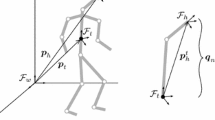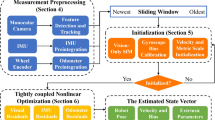Abstract
All mobile bases suffer from localization errors. Previous approaches to accommodate for localization errors either use external sensors such as lasers or sonars, or use internal sensors like encoders. An encoder’s information is integrated to derive the robot’s position; this is called odometry. A combination of external and internal sensors will ultimately solve the localization error problem, but this paper focuses only on processing the odometry information. We solve the localization problem by forming a new odometry error model for the synchro-drive robot then use a novel procedure to accurately estimate the error parameters of the odometry error model. This new procedure drives the robot through a known path and then uses the shape of the resulting path to estimate the model parameters. Experimental results validate that the proposed method precisely estimates the error parameters and that the derived odometry error model of the synchro-drive robot is correct.
Similar content being viewed by others
References
Adam, A., Rivlin, E., and Rostein. H. 1999. Fusion of fixation and odometry for vehicle navigation. IEEE Trans. on Systems, Man, and Cybernetics, 29(6):593–603.
Beer, F.P. and Johnston, E.R. 1994. Vector mechanics for engineers. McGraw Hill, pp. 344–345.
Borenstein, J. and Feng. L. 1996a. Measurement and correction of systematic odometry errors in mobile robots. IEEE Trans. on Robotics and Automation, 12(6):869–880.
Borenstein, J. and Feng, L. 1996b. Gyrodometry: A new method for combining data from gyros and odometry in mobile robots. International Conference on Robotics and Automation, 423–428.
Chong, K.S. and Kleeman, L. 1999. Mobile robot map building for an advanced sonar arrray and accurate odometry. International Journal of Robotics Research, 18(1):20–36.
Choset, H. and Nagatani, K. 2001. Topological SLAM: Toward exact localization without explicit localization. IEEE Trans. on Robotics and Automation, 17(2):125–137.
Chung, H., Ojeda, L., and Borenstein. J. 2001. Accurate mobile robot dead-recknoing with a precision-calibrated fiber-optic gyroscope. IEEE Trans. on Robotics and Automation, 17(1):80–84.
Duckett, D., Marsland, S., and Shapiro, J. 2000. Learning globally consistent maps by relaxation. International Conference on Robotics and Automation, 3841–3846.
Fox, D., Burgard, W., and Thrun, S. 1999. Markov localization for mobile robots in dynamic environments. Journal of Artificial Intelligence, 11:391–427.
Jensfelt, P. and Kristensen, S. 2001. Active global localization for a mobile robot using myltiple hypothesis tracking. IEEE Trans. on Robotics and Automation, 17(5):748–760.
Kelly, A. 2004. Linearized error propagation in odometry. International Journal of Robotics Research, 23:179–218.
Kim, M.C., Chung, W.K., and Youm. Y. 1999. Posture estimation of car-like mobile robot using disturbance conditions. Advanced Robotics, 13(2):189–202.
Kim, S.B., Choi, K., Lee, S., Choi, J., Hwang, T., Jang, B., and Lee, J. 2004. A bimodal approach for land vehicle localization. ETRI Journal, 26(5):497–500.
Larsen, T.D., Bak, M., Andersen, N.A., and Ravn, O. 1998. Location estimation for autonomously guided vehicle using an augmented kalman filter to autocalibrate the odometry. FUSION 98, Spie conference Las Vegas.
Martinelli, A. 2002. The odometry error of a mobile robot with a synchronous drive system. IEEE Trans. on Robotics and Automation, 18(3):399–405.
Martinelli, A., Tomatis, N., Tapus, A., and Siegwart, R. 2003. Simultaneous localization and odometry calibration for mobile robot. IEEE/RSJ Int. Conf. on Intelligent Robots and Systems, 1499–1504.
Murata, S. and Hirose, T. 1993. Onboard locating system using real-time image processing for a self-navigating vehicle. IEEE Trans. on Industrial Electronics, 40(1):145–154.
Roy, N. and Thrun, S. 1999. Online self-calibration for mobile robots. International Conference on Robotics and Automation, 2292–2297.
Wang, C.M. 1988. Location estimation and uncertainty analysis for mobile robots. International Conference on Robotics and Automation, 1230–1235.
Author information
Authors and Affiliations
Additional information
Nakju Lett Doh received his BS, his MS, and his Ph.D. degree in Mechanical Engineering from Pohang University of Science and Technology (POSTECH), KOREA, in 1998, 2000, and 2005, respectively. Since then, he is a senior researcher in Intellgient Robot Reserarch Division, Electronics and Telecommunications Research Institute (ETRI), KOREA. He received the glod prize in Intelligent Robot Contest hosted by Northern KyoungSang Province at 2000 and the gold prize in Humantech Thesis Competition hosted by Samsung Electronics at 2005. In 2003, he got the best student paper award in IEEE International Conference on Robotics and Automation held in Taiwan. His research interests are the localization and navigation of mobile robots and ubiquitous robotic space for intelligent robot navigation.
Howie Choset is an Associate Professor of Robotics at Carnegie Mellon University where he conducts research in motion planning and design of serpentine mechanisms, coverage path planning for de-mining and painting, mobile robot sensor based exploration of unknown spaces, and education with robotics. In 1997, the National Science Foundation awarded Choset its Career Award to develop motion planning strategies for arbitrarily shaped objects. In 1999, the Office of Naval Research started supporting Choset through its Young Investigator Program to develop strategies to search for land and sea mines. Recently, the MIT Technology Review elected Choset as one of its top 100 innovators in the world under 35. Choset directs the Undergraduate Robotics Minor at Carnegie Mellon and teaches an overview course on Robotics which uses series of custom developed Lego Labs to complement the course work. Professor Choset’s students have won best paper awards at the RIA in 1999 and ICRA in 2003. Finally, Choset is a member of an urban search and rescue response team using robots with the Center for Robot Assisted Search and Rescue. Now, he is active in extending the mechanism design and path planning work to medical mechatronics.
Wan Kyun Chung received his BS degree in Mechanical Design from Seoul National University in 1981, his MS degree in Mechanical Engineering from KAIST in 1983, and his Ph.D. in Production Engineering from KAIST in 1987. He is Professor in the school of Mechanical Engineering, POSTECH (he joined the faculty in 1987). In 1988, he was a visiting professor at the Robotics Institute of Carnegie-Mellon University. In 1995 he was a visiting scholar at the university of California, Berkeley. His research interests include the localization and navigation for mobile robots, underwater robots and development of robust controller for precision motion control. He is a director of National Research Laboratory for Intelligent Mobile Robot Navigation. He is serving as an Associate Editor for IEEE Tr. on Robotics, international editorial board for Advanced Robotics.
Rights and permissions
About this article
Cite this article
Doh, N.L., Choset, H. & Chung, W.K. Relative localization using path odometry information. Auton Robot 21, 143–154 (2006). https://doi.org/10.1007/s10514-006-6474-8
Published:
Issue Date:
DOI: https://doi.org/10.1007/s10514-006-6474-8




